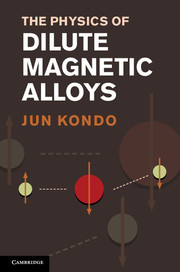Preface
Published online by Cambridge University Press: 05 March 2013
Summary
I wrote this book as an introduction to the theory of electrons in metals. There are a good many texts on this topic, and the emphasis of this present book is in discussing the physics of dilute magnetic alloys. The first half of this book is devoted to discussion of the topics that are necessary for the discussions in the later chapters. Recent activity in the theory of dilute magnetic alloys has made the field highly complex, so I have tried to describe this at a level that is suitable for those who are new to the subject area.
While metals are characterized by the presence of electrons that move about freely in them, it is most important that, unlike in semi-conductors, there is huge electron density. As a result, quantum effects become predominant and, because electrons are fermions, the phenomenon of degeneracy takes place. We may even go so far as to say that almost all of the characteristic behavior of metals is due to this phenomenon of degeneracy.
Concerning the quantum theory of electrons in metals, there have been five major developments. The first is the Sommerfeld theory, which introduced the concept of degeneracy to explain the behavior of the electronic specific heat. The second is the Bohm-Pines theory, which discusses the effect of the inter electronic Coulomb interaction, together with the many-body treatment of the problem which emerged from this theory.
- Type
- Chapter
- Information
- The Physics of Dilute Magnetic Alloys , pp. ix - xPublisher: Cambridge University PressPrint publication year: 2012



